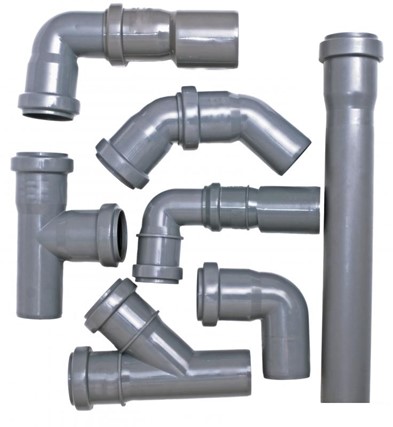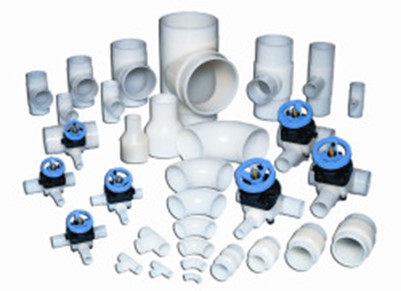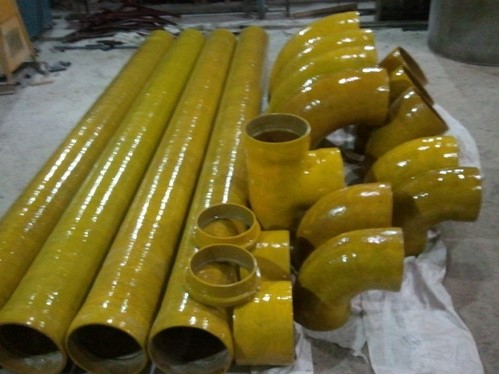1. Introduction to Plastic Piping System:
Because corrosion is a problem in operating and maintaining any Chemical Process Plant, one would prefer avoiding steel completely as a piping material but since its not feasible because of the usefulness of steel in sustaining the Pressure and Temperature conditions normally foreseen in any Process Plant. That brings the concept of composite piping constructed from the highly Chemical Resistant Polymer Compounds as base material, reinforced with suitable fibrous materials such as Glass which provides it the requisite strength.
2. PLASTIC MATERIALS:
Basically 3 types of Synthetic Polymer Components have found acceptance in industrial use.
- Thermoplasts
- Thermosets
- Composite Plastics
2.1 Thermoplasts:
The Thermoplastics are Polymer Compounds, which are normally available in crystal form.
On application of heat and pressure these crystals attain the requisite level of flowability to be able to attain the desired shape by molding process. On re-heating the plastic material can once again undergo the transformation from solid to a flowable state which allows their reprocessing into the desired shape.
Some of the commonly used Thermoplasts are as follows
- Polyethylene
- Polypropylene
- Polystyrene
- Polyvinyl Chloride
- Fluor-Plastics
By and large the thermoplastics are structurally weak materials and have limited temperature endurance.

Fig 1.Thermoplast Piping Components
2.2 Thermosets:
The Thermosetting Plastics are Polymer Compound (resins), which are normally available in liquid form at ambient temperature. On addition of Catalyst and Accelerator these Resins undergo a chemical transformation into a rigid product that sets into the required shape by curing process.
Some of the commonly used Thermosetting Plastics are as follows.
- Epoxies
- Furans
- Phenolics
- Polyesters – Bisphenol, Isophthalic, Halogenated
- Polyurethane
- Vinyl esters
Even though the Thermosetting Plastics are relatively superior to Thermoplastics in terms of structural strength and temperature endurance, still in its virgin form they find limited use in Industrial applications.

Fig 2.Thermoset Piping Components
2.3 Composite Plastics:
As it is evident from the foregoing discussion that both Thermoplastics and Thermosetting Plastics in their virgin form lack ability to sustain the level of mechanical loading normally encountered in the Industrial applications. An attempt to strike an appropriate balance between the two desired properties of the material (i.e. Mechanical Strength and Corrosion Resistance) therefore has always remained a desirable objective. This brought forward the concept of Composite Plastics where in a reasonable degree of mechanical strength is imparted to the base Polymer which in itself is adequately resistant to the Chemical Corrosion, by way of reinforcing it with a suitable reinforcing material.
Most of the commercially available composite materials in the Reinforced Plastic category use
a combination of Thermosetting Plastic Resins (e.g. Polyester, Epoxy, Vinyl Ester etc.) and Fiberglass or Synthetic Fibers as reinforcing material. In order to provide an ultra superior chemical resistance, it is also possible to manufacture a composite material using Thermoplastic Material (e.g. PVC, PVDF, PP etc) as a base liner over which the layers of Thermosetting Resins and Fiberglass are applied to attain the required mechanical strength.
Manufacturing Process:
The composite plastics pipes are commonly produced by 1 of the following methods
- Custom Contact Molding:
It is a manual/ semi automated process in which the composite sections are manufactured by application of various layers of resin and Glass Fibers (in various forms such as surface mat, roving mat, chop-strand mat etc.) either by Hand Lay-up or by Spray Lay-up method.
- Filament Winding:
It is a fully automatic process in which an automatic control over winding angle (0 to 90 degree) and winding pressure can be exercised to obtain the varying degree of Hoop – Axial ratio and Glass – Resin percentage composition. Normally a winding angle of 54 3/ 4 Degree provides a 2:1 Hoop – Axial ratio which is condition of optimum internal pressure requirement. By increasing the winding pressure the Glass – Resin proportion could be varied from 80 % – 20 % to 60% – 40 %. A composite section of high Glass content will result into high strength and low chemical resistance and visa versa.
- Pultrusion:
As the name implies this is a sort of extrusion process by pulling the filaments through a resin bath tub and subsequently passing it through an extruding die and then through a an atmosphere of controlled elevated temperature. The above process is commonly used for manufacturing rolled sections such as Angles, Channels, I Beams etc.
- Resin Transfer Molding:
The above process is used for specialized applications for manufacture of sandwich structures with certain core material.

Fig 3.Composite Piping Components
3. TYPICAL MECHANICAL PROPERTIES OF THERMOSETTING PLASTIC:
The Reinforced Thermosetting Plastic Material typically represents a mechanically weak structure with high coefficient of thermal expansion, low thermal conductivity and high strength – weight ratio. The approximate values of various mechanical properties of the Reinforced Plastic are in the following range.
Density 0.055 – 0.065 Lbs / inch3
Coefficient of 9 – 13 in/ in O F x 10-6
Thermal Expansion
Modulus of Elasticity 1.0 – 3.0 PSI * 106
Ultimate Tensile Strength 12 – 100 PSI * 103
Yield Strength 12 – 100 PSI * 103
Thermal Conductivity 1.5 – 2 BTU/ Hr. Ft OF
what are the equipments used in piping design????